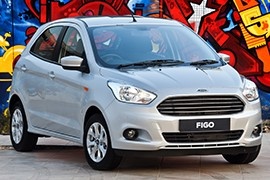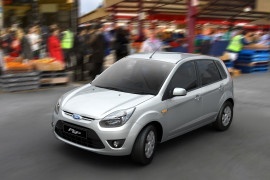
FORD Figo
Generations Timeline, Specs and Pictures

The second generation of the Ford Figo was the Indian brother of the European Ford Ka+.
It was unveiled in 2015 and refreshed three years later.
The Indian market was keen for small-sized vehicles, due to crowded cities and small parking spaces. The price was an important factor as well. With that said, Ford decided to offer a low-budget vehicle but with high standards of safety and quality.
The facelifted Figo featured a new bumper design, with integrated foglights on the outer side. A “C” trim was mounted on the sides of the apron for the Blue trim level (top-spec). A new set of light-alloy wheels was available on the options list. In the back, Ford enhanced the bumper and installed a roof-spoiler with integrated third brake light.
Inside, the base model featured two airbags, but the top-of-the-range version was fitted with an infotainment system, six airbags, and the word “Blue” embroiled on the seatbacks of the front seats. The car was fitted with air-conditioning and four power windows and locks.
Under the hood, the 2018 Ford Figo was fitted with a new engine: the 1.2-liter gasoline unit. It offered 95 hp and it was paired as standard to a five-speed manual. Another option was the 1.5-liter turbo diesel, mated to a 5-speed manual as well.

The American carmaker introduced the second generation of the Figo for the Indian market in 2015 based on the same platform as the European Ford Ka.
While the first generation of the Figo sat on a Fiesta platform, the second generation used a Ka+ base. It might seem a downgrade, but it wasn’t. The car even sported a longer wheelbase and used similar technical solutions but enhanced. Strangely, Ford chose to launch the three-box version of the Figo (Figo Aspire) first, and then the hatchback came later. Its new bodywork included high-strength steel and improved shock-absorbing areas.
On the outside, the former boxy shape of Figo’s first generation was gone. It was the time for rounded shapes and new, angled, and angular-shaped headlights. Its “aston-esque” grille featured four horizontal chromed lines. On its sides, the carmaker installed a set of sculptured doors. It adopted the same solution for the European Ka+, which was available in selected countries.
The interior was not among the best in its class, but it offered enough comfort and features for daily use. Its instrument panel sported a large speedometer in the middle flanked by a tachometer on the left and a fuel level on its right side. Strangely, there wasn’t any coolant-temperature gauge. Its role was taken by a simple blue and red indicator light. The materials used on the dash panel, door cards, and center stack were not high-end, but they were good enough for the car’s price.
Ford offered the small vehicle with a choice of three engines paired as standard to a five-speed manual. The Figo S provided a 1.5-liter 111 hp powerplant paired as an option with a six-speed automatic for the top-spec version. A turbo-diesel unit was available as well.

Ford introduced the Figo on the Indian market in 2009 and refreshed it three years later and made it more appealing to the market.
At a glance, some would not notice that the 2009 Figo was, in fact, the 5th generation of the European Ford Fiesta with a different face. The American brand used the same platform for both vehicles, and that was common. But they didn’t change the car’s shape or the taillights.
In 2012, Ford updated the facelifted Figo’s front fascia with a larger grille on the lower part of the bumper, with a hexagonal shape. The non-facelifted version featured a trapezoidal grille. Moving up to the headlights, they were similar, if not exactly the same, with those installed on the European Ford Ka. But the designers managed to blend the modern lines of the front with the 2002 Fiesta’s lines from the back.
Inside, Ford designed a new instrument cluster, which was not available for any European models, with a big center speedometer and the tachometer on the left. Inside the speedometer dial, the carmaker installed the fuel gauge. Most of its interior parts were carried over from the European model, and that included the hood opener, which was placed on the left side of the vehicle, in a car built for an RHD country.
Under the hood, the blue-oval brand offered the Figo with a choice of gasoline and diesel engines ranged between 71 hp and 99 hp. All versions were paired to a 5-speed manual gearbox.

The new subcompact car from Ford was unveiled in September 2009 in New Delhi, India.
This small car was named “Figo” after the informal expression in Italian, meaning “Cool”. Oriented towards the Indian and Asian-Pacific markets, the Figo is built on Fiesta’s B platform. In terms of styling the Figo looks more like a facelifted fifth generation Fiesta (2002 - 2008), but fits in perfectly with the consumer demand and purchasing power from developing countries. The units powering the Figo, were chosen to be the 1.2-liter petrol and the 1.4-liter TDCi Duratorq diesel engine, both tuned for low fuel consumption and reduced CO2 emissions.























































